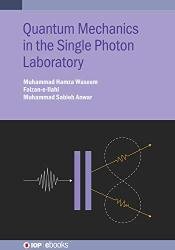Quantum Mechanics in the Single Photon Laboratory
- Добавил: literator
- Дата: 29-01-2022, 16:46
- Комментариев: 0
 Название: Quantum Mechanics in the Single Photon Laboratory
Название: Quantum Mechanics in the Single Photon LaboratoryАвтор: Muhammad Hamza Waseem, Faizan-e-Ilahi
Издательство: IOP Publishing
Год: 2020
Страниц: 183
Язык: английский
Формат: pdf (true), epub
Размер: 17.9 MB
Arising from a series of laboratory class experiments developed by the authors, this book provides an overview of fundamental experiments that can be used to practically demonstrate the underlying principles of quantum physics and quantum information science. Designed with multiple readerships in mind, it will be essential for the professor who would like to recreate a similar suite of experiments for their students as well as students of physics, who would like to learn how such experiments are conducted. Computer scientists, photonics engineers and electrical engineers who would like to foray into quantum technologies would also find this narrative useful to learn about the terminology, key postulates of quantum physics, the collapse of states on measurement and how quantum computers could be implemented.
The book starts with a survey of how research labs around the world have helped create a portfolio of some wonderful experiments that can be easily translated for instructional purposes in physics teaching laboratories worldwide. As such, these experiments are a true distillation of cutting-edge research in quantum optics and quantum information science with single photons and epitomize how research in the laboratory can directly enrich the teaching of a counter-intuitive mathematical and physical framework that we call the quantum theory. Since our working units for qubits are photonʼs polarization state, we make a brief digression into the classical picture of light. Some of the mathematical tools introduced in the second chapter, carry over, in a quantum garb, to the quantum experiments. We also describe some experiments with lasers that can act as a spring board for the quantum experiments.
Enter the quantum description of nature with states of qubits living on the Bloch sphere. The third chapter builds just enough of the mathematical description that is required to understand how we explain quantum states, how they change with time or when acted upon by certain transforming elements, and finally, how do we measure them. Connections with photon polarization are built as we move along. This chapter also provides us the opportunity to introduce quantum entanglement, which is hailed as the quantum worldʼs most closely guarded and most cherished secret.
The background material which spans over three chapters is not a substitute to a standard semester long course on quantum mechanics, but does provide enough material to the non-physics major, or engineer, or even the general science student, to understand how quantum mechanics unfolds in reality, inside a laboratory and is not a mere textbook thought experiment but can reveal itself in full glory with simple, ‘but not simpler’ instruments and gadgets.
Finally, chapters 4–6 describe the experiments. We have made a conscious effort in classifying these experiments into three categories: those that deal with the ‘quantumness’ of these quantum experiments, those that demonstrate how the quantum reality is neither local nor realist and finally, how we can measure the quantum state. All of these various kinds of experiments highlight one aspect or the other of quantum reality.
The appendix lists a commented version of the complete program written for the coincidence counting unit. The code is written in Verilog, a common hardware description language, and is burnt on Xilinx Nexys 2 FPGA. It essentially counts pulses corresponding to single and coincidence photodetections, and transmits the count rates to a computer every 0.1 s.
Key Features:
Accompanied by downloadable code and data from real experiments for readers to manipulate, plot and compute expectation values, errors and density matrices.
Includes worked examples demonstrating basic calculations on computing probabilities from projective measurements, effect of unitary operators on states, computing density matrices, and expectation values, fidelities and purities.
Features end-of-chapter problems
Incorporates overviews and learning objectives for each chapter
Essential reading for students of quantum physics and modern optics
Скачать Quantum Mechanics in the Single Photon Laboratory
Внимание
Уважаемый посетитель, Вы зашли на сайт как незарегистрированный пользователь.
Мы рекомендуем Вам зарегистрироваться либо войти на сайт под своим именем.
Уважаемый посетитель, Вы зашли на сайт как незарегистрированный пользователь.
Мы рекомендуем Вам зарегистрироваться либо войти на сайт под своим именем.
Информация
Посетители, находящиеся в группе Гости, не могут оставлять комментарии к данной публикации.
Посетители, находящиеся в группе Гости, не могут оставлять комментарии к данной публикации.
